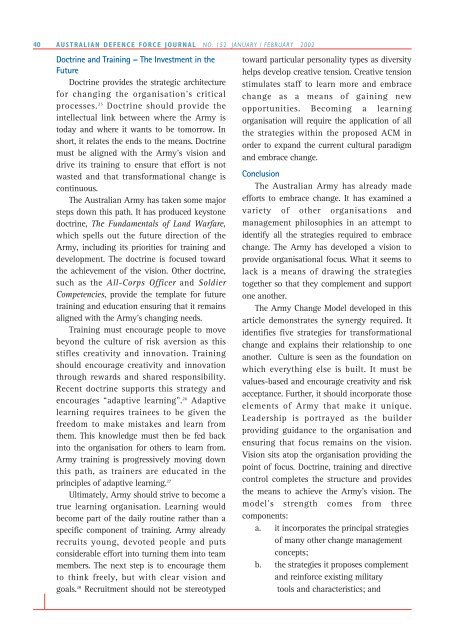ISSUE 152 : Jan/Feb - 2002 - Australian Defence Force Journal
ISSUE 152 : Jan/Feb - 2002 - Australian Defence Force Journal
ISSUE 152 : Jan/Feb - 2002 - Australian Defence Force Journal
- No tags were found...
Create successful ePaper yourself
Turn your PDF publications into a flip-book with our unique Google optimized e-Paper software.
40AUSTRALIAN DEFENCE FORCE JOURNAL NO. <strong>152</strong> JANUARY / FEBRUARY <strong>2002</strong>Doctrine and Training – The Investment in theFutureDoctrine provides the strategic architecturefor changing the organisation’s criticalprocesses. 25 Doctrine should provide theintellectual link between where the Army istoday and where it wants to be tomorrow. Inshort, it relates the ends to the means. Doctrinemust be aligned with the Army’s vision anddrive its training to ensure that effort is notwasted and that transformational change iscontinuous.The <strong>Australian</strong> Army has taken some majorsteps down this path. It has produced keystonedoctrine, The Fundamentals of Land Warfare,which spells out the future direction of theArmy, including its priorities for training anddevelopment. The doctrine is focused towardthe achievement of the vision. Other doctrine,such as the All-Corps Officer and SoldierCompetencies, provide the template for futuretraining and education ensuring that it remainsaligned with the Army’s changing needs.Training must encourage people to movebeyond the culture of risk aversion as thisstifles creativity and innovation. Trainingshould encourage creativity and innovationthrough rewards and shared responsibility.Recent doctrine supports this strategy andencourages “adaptive learning”. 26 Adaptivelearning requires trainees to be given thefreedom to make mistakes and learn fromthem. This knowledge must then be fed backinto the organisation for others to learn from.Army training is progressively moving downthis path, as trainers are educated in theprinciples of adaptive learning. 27Ultimately, Army should strive to become atrue learning organisation. Learning wouldbecome part of the daily routine rather than aspecific component of training. Army alreadyrecruits young, devoted people and putsconsiderable effort into turning them into teammembers. The next step is to encourage themto think freely, but with clear vision andgoals. 28 Recruitment should not be stereotypedtoward particular personality types as diversityhelps develop creative tension. Creative tensionstimulates staff to learn more and embracechange as a means of gaining newopportunities. Becoming a learningorganisation will require the application of allthe strategies within the proposed ACM inorder to expand the current cultural paradigmand embrace change.ConclusionThe <strong>Australian</strong> Army has already madeefforts to embrace change. It has examined avariety of other organisations andmanagement philosophies in an attempt toidentify all the strategies required to embracechange. The Army has developed a vision toprovide organisational focus. What it seems tolack is a means of drawing the strategiestogether so that they complement and supportone another.The Army Change Model developed in thisarticle demonstrates the synergy required. Itidentifies five strategies for transformationalchange and explains their relationship to oneanother. Culture is seen as the foundation onwhich everything else is built. It must bevalues-based and encourage creativity and riskacceptance. Further, it should incorporate thoseelements of Army that make it unique.Leadership is portrayed as the builderproviding guidance to the organisation andensuring that focus remains on the vision.Vision sits atop the organisation providing thepoint of focus. Doctrine, training and directivecontrol completes the structure and providesthe means to achieve the Army’s vision. Themodel’s strength comes from threecomponents:a. it incorporates the principal strategiesof many other change managementconcepts;b. the strategies it proposes complementand reinforce existing militarytools and characteristics; and
















